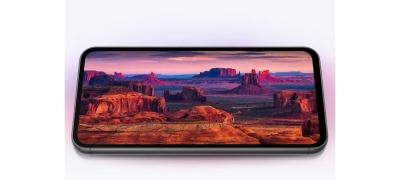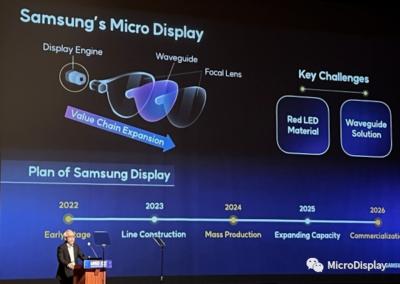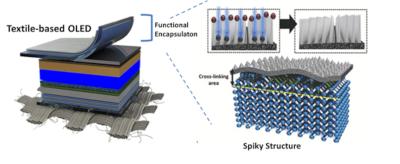OLED Encapsulation: introduction and market status
OLED (Organic Light Emitting Diodes) is a flat light emitting technology, made by placing a series of organic thin films (usually carbon based) between two conductors - and these films light up when electrical current is applied. OLEDs are used to make display and lighting panels. OLED displays an offer excellent image quality, are thinner, more efficient than LCD displays, and they can be flexible.

One of the major problems with those organic materials is that they are very sensitive to oxygen and moisture. This means that OLEDs need to be protected - as even a single water or oxygen molecule can harm the OLEDs.
Thin Film Encapsulation (TFE)
With regular (rigid) OLED panels, one can use a glass sheet. Glass is a great barrier, and it is widely used in the display industry and so easy to handle.
For flexible panel, rigid glass is not a a good option, and in such panels producers use different techniques, collectively referred to as Thin Film Encapsulation, or TFE. TFE is a multi-layer film, made from alternating organic and inorganic layers.
Most organic layer TFEs use an inkjet printing process. Inkjet printing is used to deposit the organic TFE materials. Kateeva launched an encapsulation inkjet printer system towards the end of 2014, and in 2016 the company announced that it secured the "vast majority" of available TFE orders. Since then it is believed that most, if not all, AMOLED displays are protected by inkjet printed TFEs (the organic layers).
The inorganic TFE material deposition can be done in different methods, including Plasma-enhanced chemical vapor deposition (PECVD) and Atomic Layer Deposition (ALD), that enables thinner and more uniform films.
Further reading
LG Display to retrofit its iPad AMOLED line to produce iPhone OLEDs as Apple reduces its tablet display orders
In late 2024 we reported several times that demand for Apple's iPad Pro devices is lower than expected, and the company reduced its OLED panel orders from both Samsung and LG.
According to a new report from Korea, LG may decide to start using its IT AMOLED production line to produce smartphone displays. The company looks to supply 70 million iPhone AMOLED displays to Apple in 2025, up from around 65 million in 2024 (and 52 million in 2023). Converting the IT AMOLED line to smartphone panel production will enable LGD to increase capacity without a large investment in new equipment.
Applied Materials launches a maskless OLED production technology, to support 8-Gen high efficiency OLED deposition and encapsulation
Applied Materials announced a technology, branded as MAX OLED that enables OLED display production on large glass substrates, aiming to provide a cost-effective solution to produce TV and TV displays. Applied developed and patented a new OLED pixel architecture and a "dramatically different manufacturing approach" that the company says enables brighter, clearer, more energy-efficient and longer-lasting.
Applied's new MAX OLED systems can scale from 6-Gen substrates to 8-Gen substrates, supporting the new wave of IT OLED production lines. Applied says that its new solution has strong customer interest - and already achieved repeat orders from several leading display makers (see below). Specifically, Applied announced that it will supply an R&D system to Samsung Display that will test the new production technology for its AMOLED and QD-OLED production technologies.
Everdisplay to delay production at its new Shanghai 6-Gen OLED production line by one year
China-based AMOLED producer Everdisplay is constructing a new 6-Gen production line in Shanghai, an expansion of its existing fab. The company's original plan was to start mass production in December 2024, but it now announced it will delay this and mass production is now only expected in december 2025. This is the second delay of this project.

Everdisplay says that the reason for the delay is that the company wishes to upgrade the line to the latest OLED technologies, such as LTPO backplanes, Tandem stack architecture and a hybrid platform (which means rigid OLEDs with TFE encapsulation and a glass backplane).
Microsoft signs up Samsung Display to supply it with OLED microdisplays for a 2026 headset
According to reports from Korea, Microsoft has signed an agreement with Samsung Display for the supply of OLED microdisplays for a future MX device, that Microsoft plans to launch in the future (likely 2026 or later).
Microsoft agreed to order a few hundreds of thousands of units of Samsung's OLED microdisplays. Samsung Display is collaborating with Samsung System LSI, that will design the CMOS backplane, which will be produced by Samsung Foundry. Samsung Display will handle the frontplane OLED deposition and encapsulation.
TCL CSOT shows its latest OLED, MicroLED and QD-EL displays at Displayweek 2024
TCL CSOT demonstrated its latest displays, technologies and prototypes at Display Week 2024. The company is focused on inkjet printing technologies, and a lot of the displays on show were indeed printed.
So first up, we TCL demonstrated a 14" 2880x1800 400 nits 30-120Hz ink-jet printed LTPO AMOLED display. The display is produced on a glass substrate, with thin film encapsulation (a 'hybrid OLED').
Omdia: OLED tablet shipments to reach 35 million units in 2031
Omdia says that shipments of OLED displays in tablets are set to grow in the future, rising from around 3.8 million in 2023 to 35 million in 2031. 2024 will see a 315% jump in shipments as Apple starts to adopt OLEDs in its tablets.
Interestingly, Omdia sees an increase in adoption of a 'hybrid OLED' structure (reaching a market share of 85.1% in 2031), which the company defines as a glass-based OLED with a thin-film encapsulation. This hybrid design is lower in cost compared to a flexible OLEDs, while still achieving high performance and a thin design.
Researchers develop a new multi-functional encapsulation that can be used to produce fiber-based wearable OLEDs
Researchers from Korea's Gachon University, Seoul University and Chungbuk University developed a multi-functional encapsulation technology that can be used to develop fiber-based wearable OLED devices, deposited on textiles.
The new OLED device is produced on a light extraction substrate, that is super-hydrophobic - developed by coating a water-repellent layer on a rough surface obtained through ion beam treatment, ensuring excellent uniformity and easy power control. The new encapsulation offers high performance (10-6 g/m-2/day) and also achieves a UV transmission rate of less than 3%.
Toray Research Center shows how OLED inspection and analysis enable the production of higher performance OLED panels
Toray Research Center (TRC) has launched a new open online webinar focused on OLED inspection and analysis technologies. TRC, who supplies technical analysis and support for R&D and manufacturing, invites you to attend the online lectures at no cost, to get a deeper understanding on OLED inspection and analysis, and how to achieve higher performance displays. The webinar recordings are accessible until February 15.
The webinar include four presentations:
- Identification of Trace Impurities Using High-Resolution Mass Spectrometry (Toward High-Quality OLED Panels)
- Analysis of Small Molecule OLED Layers in Solution Process and Vacuum Deposition Process
- Moisture Diffusion Evaluation in Encapsulant
- Analysis of QD sheet (Quantum Dot Enhancement Film)
The first presentation, titled Identification of Trace Impurities Using High-Resolution Mass Spectrometry (Toward High-Quality OLED Panels), details examples of possible degradation in OLED devices that lead to performance reduction. In this presentation, TRC discusses the role of analysis, the advantages of high mass resolution, different evaluation techniques and how it can help developers increase the performance of OLED displays.
LG Display reveals its automotive display strategy and its latest OLED customers
LG Display detailed its latest automotive display strategy. The company is now offering three product families. For luxury flagship cars (over $80,000 in cost), the company is offering its P-OLED flexible panels, that offer high performance coupled with design freedom.
For premium cars ($50,000 - $80,000) the company offers rigid OLEDs, that offer high image quality and a tandem OLED architecture for increased efficiency and lifetime. These displays are lower in cost compared to LG's P-OLEDs, and LG brands these as ATO (Advanced Thin OLEDs) as they adopt TFE encapsulation over a glass substrate. For mass market cars ($30,000 - $50,000) LGD offers LTPS LCDs.
Samsung and LG are developing bezel-less smartphone OLED displays for Apple
According to a report from Korea, Apple approached both LG Display and Samsung Display, asking its suppliers to develop a completely bezel-less AMOLED display for future iPhones.

Designing an OLED without a bezel is a challenge, mostly because of the encapsulation layer that has to protect the OLEDs. Using an under-the-display camera is also said to be a problem for the OLED makers in such a design.
Pagination
- Page 1
- Next page








